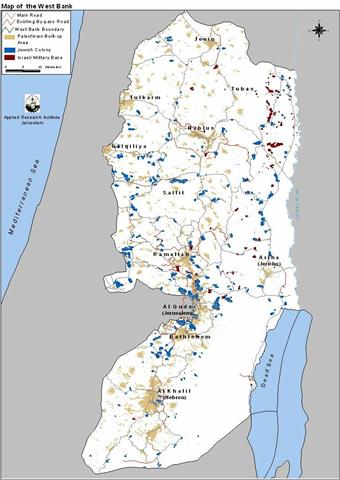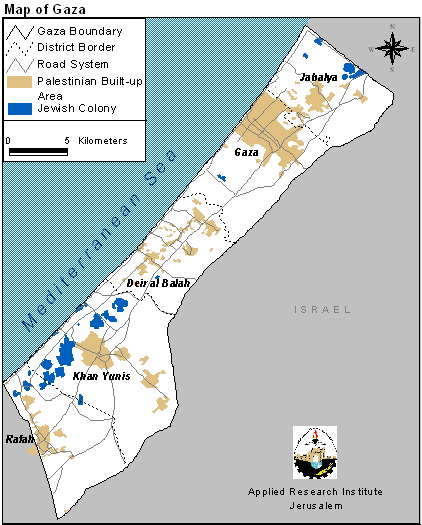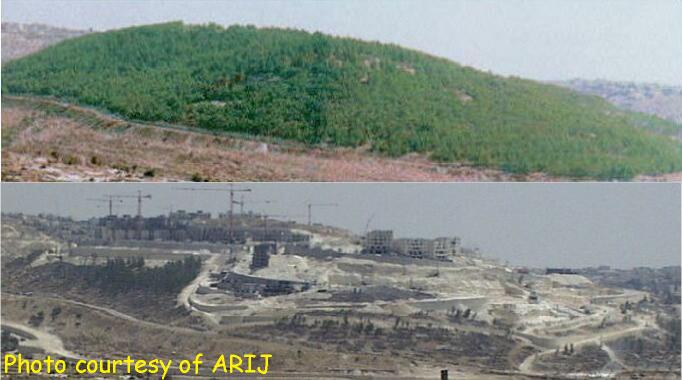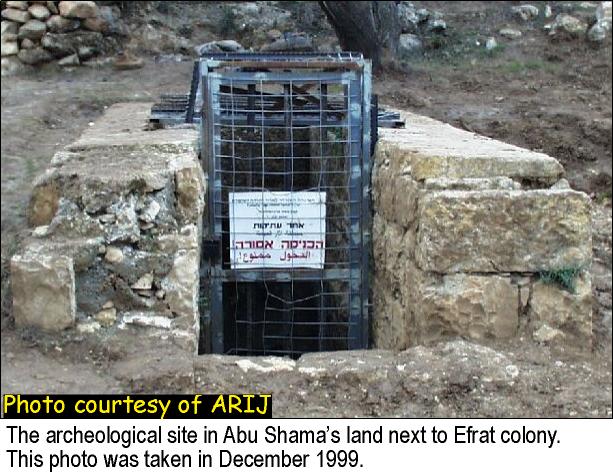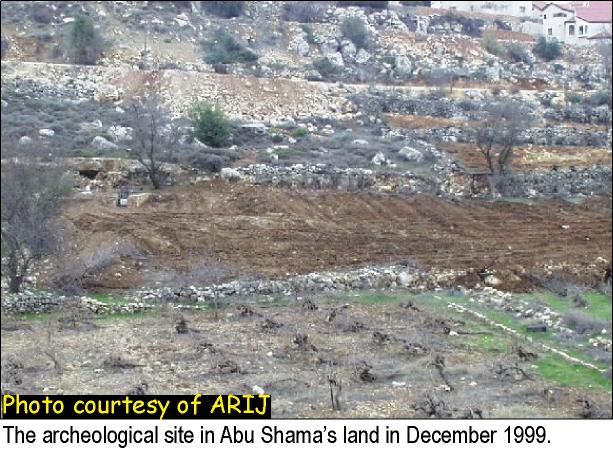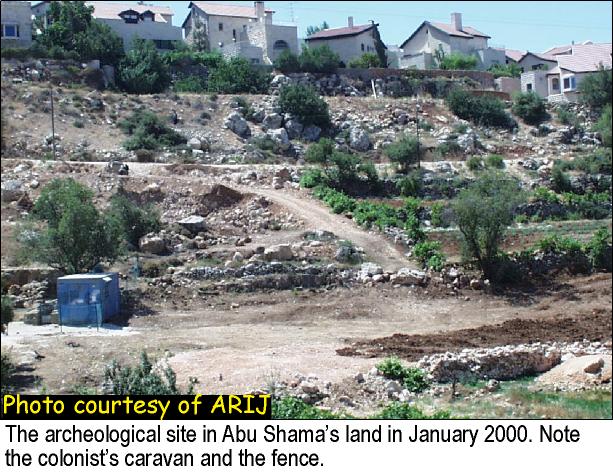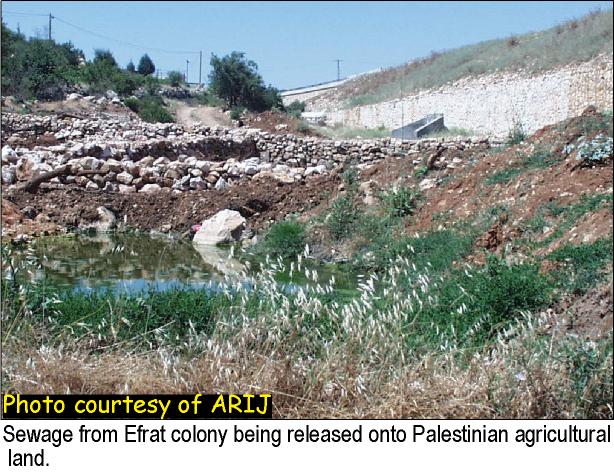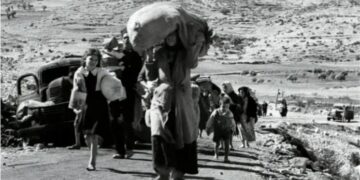May -July 2000
This report highlights the events concerning colonizing activities in the West Bank and Gaza that occurred between the months of May and July. The report describes and evaluates those events and their effects on the Palestinian community. The report also tries to predict the repercussions expected in the future as a result of those events.
The West Bank (excluding Jerusalem)
For background information on the West Bank . The Israeli violations that were reported between the months of May till July are reported in the following table.
|
Table 1: Israeli Violations in the West Bank from May to July 2000 |
||||
|
Date |
Violation |
Location |
Violators |
|
|
1-May-00 |
C – Approving the construction of 1600 new housing units. See photo1, photo2.., . |
Ramallah – Mod'in settlement |
The Israeli Housing Ministry |
|
|
5-May-00 |
S – an attempt to confiscate a Palestinian family's house |
Hebron |
Jewish settlers |
|
|
5-May-00 |
S – Posting signs declaring the area a military zone |
Ramallah -Kafr Malik village |
The Israeli soldiers |
|
|
10-May-00 |
E – Excavation works are taking place to expand the settlement of Shavei Shomron. |
Nablus -Deir Sharaf village |
The Israeli bulldozers |
|
|
10-May-00 |
S – Prohibition of the villagers from cultivating their land, which is estimated at 5000 dunums, as a preparation to seize it. Click for related topic.. |
Bethlehem -al Khadr village |
The settlers of Elazar |
|
|
10-May-00 |
C – Installing a new caravan |
Hebron -Qiryat Arba settlement. |
The Israeli occupation authorities |
|
|
10-May-00 |
C – Establishing new electrical & water networks |
Hebron-Zanuta village |
The Israeli army |
|
|
11-May-00 |
P – Approving a plan to construct a new by-pass road, |
Bethlehem -Za'tara & Beit Sahour |
The Israeli Defense Ministry |
|
|
13-May-00 |
C – Commencement for building five apartments and a large settlement building on a seized land owned by Palestinians. See photo1, . |
Hebron -Adh Dhahiriya village |
The settlers of Tene |
|
|
18-May-00 |
S – Declaring about 85% of the land as a closed military zone for training purposes. |
Nablus -Aqraba village |
The Israeli authorities |
|
|
18-May-00 |
S – Surveying a piece of land estimated at 150 dunums |
Jenin -Tura al Gharbiya village |
The Israeli surveyors |
|
|
20-May-00 |
S – Prevention of the villagers from working in their land |
Nablus -Bit Furik village |
The settlers of Itmar |
|
|
20-May-00 |
E – Attacking a Palestinian land, in an attempt to expand Ateret settlement |
Ramallah – 'Ajjul village |
The settlers |
|
|
20-May-00 |
C – Erection of a fence around 4 dunums of land |
Hebron |
The settlers of Kfar Etzion |
|
|
21-May-00 |
C – Starting the preparation to establish a new settlement neighborhood. Click for more. |
Qalqiliya – 'Azzun and 'Isla villages |
The Israeli Military Authorities |
|
|
22-May-00 |
C – Setting up several mobile homes on an area estimated at 30 dunums. |
Qalqiliya -Kafr Qaddum village |
The settlers of Qadumim settlement |
|
|
22-May-00 |
C – Establishing sanitary networks |
Nablus -Kafr Sur village (Khalet Alfuqaha') |
The settlers of Salfit |
|
|
25-May-00 |
R – A new and fixed army roadblock has been erected. The roadblock was first installed at the entrance of Susiya settlement three months ago. Click for related topic. |
Hebron -Karmel settlement |
The Israeli government |
|
|
26-May-00 |
R – Continue to open the by-pass road which aimed at linking the settlements in Ramallah with those in Salfit and to connect it with Trans-Samaria2. |
Nablus – Nablus (city) |
The occupation authorities |
|
|
26-May-00 |
P – Endorsement of a plan to build a new settlement neighborhood that comprises 500 housing units on confiscated Palestinian land |
Hebron -Surif village |
The Israeli government |
|
|
27-May-00 |
S – Seizure of 200 dunums of land. Click for more.. |
Bethlehem – Kisan village |
The settlers of Maale Amos |
|
|
28-May-00 |
S – Destroying 100 dunums of agricultural land, endeavoring to expand Sensana settlement. See photo. |
Hebron – Ar Ramadin village |
Israeli army bulldozers |
|
|
30-May-00 |
R – Bulldozing 1000 dunums of land planted with olive trees in order to open another by-pass road parallel to Trans-Samaria. |
Nablus -Biddya village |
The Israeli bulldozers |
|
|
30-May-00 |
E- Confiscation of the land in an attempt to expand Avnei Hefetz settlement |
Tulkarm -Shufa village |
The Israeli occupation authorities |
|
|
30-May-00 |
C – Starting to build 70 housing units. See photo.. |
Hebron – Hagai settlement |
Jewish contractors |
|
|
1-Jun-00 |
S + U – Bulldozing 26 dunums of land and uprooting 15-year old almond trees |
Hebron – Beit Ummar & Halhul villages |
The Israeli occupation authorities |
|
|
2-Jun-00 |
C – Erecting a mobile home |
Nablus – 'Asira al Qibliya village |
The settlers of Itmar |
|
|
3-Jun-00 |
C – Starting to construct new housing units |
Nablus -Karne Shomron settlement |
The Israeli authorities |
|
|
3-Jun-00 |
U – Uprooting tens of fruitful trees belonging to Palestinian citizens. |
Bethlehem – Al Khadr village |
The settlers of Elazar |
|
|
3-Jun-00 |
O – Pumping sewage water into Palestinian agricultural land and damaging wide areas it. See photo.. |
Bethlehem – Al Khadr village |
The settlers of Elazar, Efrat & Daniel |
|
|
5-Jun-00 |
D – Demolition of a Palestinian house, under the pretext of being built without a permit. Click for more.. |
Bethlehem – Al Walajeh village |
The Israeli army bulldozers |
|
|
6-Jun-00 |
S – Attacking a Palestinian house owned by Bilal Alwaqi' |
Nablus -Burin village |
The settlers of Yizhar |
|
|
6-Jun-00 |
S – Bulldozing a 200-dunum plot cultivated with corn |
Nablus-Between Jalud and Qaryut villages |
The settler of Yizhar |
|
|
6-Jun-00 |
C – Inauguration of a new settlement neighborhood, in order to redouble the number of Jewish settlers. See photo. |
Ramallah – Kokhav Yaacov settlement |
The Israeli government |
|
|
7-Jun-00 |
C – Expansion for the chemical factory 'Gashoori' for insecticides production |
Tulkarm -Green Line |
The Israeli occupation authorities |
|
|
7-Jun-00 |
S – Stealing agricultural yield and seizing a well |
Hebron- Yatta village |
Jewish settlers |
|
|
8-Jun-00 |
S – confiscation of about 2000 dunums of land, as a preparation to build new housing units |
Bethlehem – 'Arab ar Rashayida & Kisan villages |
The settlers of Maale Amos |
|
|
8-Jun-00 |
S – Attacking Palestinian villagers, while they were working in their land and destroy about 600 m2 of retaining walls. See photo1, photo2. ., . |
Bethlehem – Al Khadr village |
The settlers of Neve Daniyyel |
|
|
11-Jun-00 |
O – Moving the army roadblock of Qiryat Sefer 150 meters away |
Ramallah -Ni'lin & Deir Qaddis villages |
the Israeli Civil Adminstration |
|
|
17-Jun-00 |
U – Uprooting more than 60 olive trees |
Ramallah -Deir Qaddis village |
The settlers of Qiryat Sefer |
|
|
18-Jun-00 |
C – Setting up more caravans on a land belonged to Musa Asairah, in an attempt to build a new settlement neighborhood |
Nablus – 'Asaira al Qabaliya village |
The settlers of Yizhar |
|
|
18-Jun-00 |
U – Burning of 16 almond and olive trees |
Nablus -Haris village |
The Israeli occupation authorities |
|
|
19-Jun-00 |
E – Annexation order to 120 dunums of confiscated land (1967), for the purpose of establishing a Jewish religious institute |
Nablus -Bardala & Ein Al-Baida villages |
The Israeli occupation authorities |
|
|
20-Jun-00 |
O – Closing off the road that leads to Yabdik well |
Qailqiliya -Jayyus village |
The Israeli military forces |
|
|
20-Jun-00 |
C – Excavation work is still going on a piece of land owned by Mohammad Saleh |
Qalqiliya-Jayyus village |
The Israeli Army |
|
|
23-Jun-00 |
C – Constructing tens of electrical lighting columns |
Nablus – 'Awarta village |
The Israeli occupation authorities |
|
|
25-Jun-00 |
C – Construction of 400 housing units, as a preparation to expand the settlement |
Bethlehem -Efrat settlement |
The Israeli Minster of Housing, Yitzhak Levy |
|
|
1-Jul-00 |
C – Construction and expansion in Qiryat Sefer settlement have continued |
Ramallah -Deir Qaddis & Ni'lin villages |
The settlers |
|
|
5-Jul-00 |
S – Eviction orders have been issued to a number of Palestinian farmers, in order to expropriate their lands |
Nablus -Tammun village |
The Israeli Civil Administration |
|
|
5-Jul-00 |
C – Excavation work is taking place in Abu Ismail Islamic site (Maqam) |
Nablus -Kafr Qallil village |
An Americancitizen of Jewish origin |
|
|
5-Jul-00 |
O – Preventing the villagers from cultivating their land |
Nablus -Al'Aqaba village |
The Israeli military forces |
|
|
5-Jul-00 |
D – Delivering demolition order for the Palestinian inhabitant Zakariya Zaid |
Jenin |
The Israeli authorities |
|
|
5-Jul-00 |
U – uprooting scores of fruitful trees cultivated on a 3-dunum plot. See photo. |
Hebron |
The Israeli bulldozers |
|
|
5-Jul-00 |
D – An attempt to demolish a retaining walls belonging to Na'el Jaradat |
Hebron -Al Baq'a hamlet |
The Israeli authorities |
|
|
5-Jul-00 |
O – Killing a Palestinian shepherd, Yousef Abu arram after he stepped on the remnants of an unexploded shell |
Hebron -yatta village |
The Israeli occupation authorities |
|
|
12-Jul-00 |
C – Fencing about 25 dunums of land, as a preparation to seize it |
Qalqiliya -Kafr Qaddum village |
The settlers of Qadumim settlement |
|
|
12-Jul-00 |
C – Constructing a large tent on the land for the purpose to build a new settlement |
Qaliqiliya -Jinsafut village |
The settlers of Karne Shomron |
|
|
13-Jul-00 |
O – Several Palestinians received dozens of notices to stop building |
Hebron – Bit 'Einun & As Samu' villages |
Israeli occupation authorities |
|
|
14-Jul-00 |
U – Uprooting about 700 olive trees |
Ramallah -Al Mughayyir village |
The Jewish settlers & the Israeli military forces |
|
|
14-Jul-00 |
D – Attacking a piece of cultivated land, removing its fence, and demolishing the retaining walls, as a preparation to annex the land to the settlement |
Bethlehem – Al Khadr village |
The settlers of Efrat |
|
|
15-Jul-00 |
O – Several Palestinians, including seven journalists were wounded |
Hebron |
The settlers of Qiryat Arba and the Israeli occupation authorities |
|
|
15-Jul-00 |
E – Bulldozing wide areas of Al Janiya village, in order to expand the agricultural tag of Dolev settlement. |
Ramallah -Al Janiya village |
the settlers |
|
|
15-Jul-00 |
C – Construction works have been continued in Dolev settlement and Talmon groups. See photo1, photo2., ., . |
Ramallah -Al Janiya & Al Mazra'a al Qibliya villages |
The settlers |
|
|
16-Jul-00 |
R – Constructing two by-pass roads connecting Avnei Hefetz settlement with Enav |
Tulqarm -close to Kafr al Labad & Shufa villages |
The settlers of Avnei Hefetz and the Israeli military forces |
|
|
16-Jul-00 |
O – Confrontations between the settlers and the villagers of Al Mughayyir. They prevented the villagers from reaching their lands |
Ramallah -Al Mughayyir village |
the settlers |
|
|
16-Jul-00 |
S – An attempt to capture 400 dunum plot belonging to Plastinian citizens. See photo.. |
Bethlehem -Al Khadr village |
The settlers of Efrat |
|
|
16-Jul-00 |
S – Prevention of the villagers from reclaiming their land, even from cultivating it |
Bethlehem -Al Khadr village |
The Israeli occupation authorities |
|
|
17-Jul-00 |
S – Bulldozing about 50 dunum of land owned by Abu Qadus family, as a preparation to be annexed to the settlement |
Nablus -Salfit (Mas-ha & Az Zawiya villages) |
The settlers of Elkana |
|
|
18-Jul-00 |
R – Constructing a military road surrounding the confiscated land with an area of 20 dunums |
Tulkarm -Shufa village |
The Israeli bulldozers |
|
|
18-Jul-00 |
O – Letting the brackish water flow to sink the sole and the main road |
Qalqiliya -Kafr Qaddum village |
The settlers of Qadumim |
|
|
19-Jul-00 |
C – Construction work on a land owned by Hassan Ali |
Qalqiliya -Kafr Qaddum village |
The Israeli bulldozers |
|
|
20-Jul-00 |
S – Confiscation of a 100-dunum plot belonged to Palestinian villagers. |
Qalqiliya -Jinsafut & Hajja villages |
The settlers of Karne Shomron |
|
|
20-Jul-00 |
S – Attacking a piece of land estimated at 22 dunums owned by Hani Abed Alhadi, as preparation to be annexed to the settlement |
Nablus -Haris village |
The settlers of Kiryat Netafim |
|
|
21-Jul-00 |
C – Adding more electricity poles and fencing the five caravans in the area. |
Nablus -Burin village |
The Jewish settlers |
|
|
23-Jul-00 |
R – Bulldozing tens of dunums , in an attempt to build a new settlement by-pass road |
Qalqiliya -Jayuus village |
The Israeli bulldozers |
|
|
24-Jul-00 |
S – Attempt to confiscate an estimated 5000 dunums of land in order to expand the nearby settlements. See photo1, photo2.., . |
Bethlehem – 'Arab ar Rashayida village |
The Israeli bulldozers |
|
|
24-Jul-00 |
S – Bulldozing large areas of land estimated at 200-300 dunum of land, in order to prepare the ground for new mobile homes |
Ramallah – Turmus'ayya village |
the settlers of Shilo |
|
|
26-Jul-00 |
C – Excavation work continued in the direction of a colonial spot and the adjacent Arial settlement. |
Nablus -Yatma village |
The Israeli bulldozers |
|
|
30-Jul-00 |
U – uprooting several olive trees, for the purpose t o establish a new settlement named hai Tal |
Qalqiliya – 'Isla, 'Azzun, 'Izbat at Tabib Ras at Tira villages |
The Israeli bulldozers |
|
|
30-Jul-00 |
U – Uprooting more than 250 vine trees and destroying several nurslings |
Bethlehem |
The settlers of Eli Azar |
|
|
30-Jul-00 |
E – Setting up a new caravan on 100 dunum plot owned by Boshnaq family, in an attempt to expand the settlement |
Bethlehem |
The settlers of Eli Azar |
|
Source: compiled from local newspapers, interviews and field survey.
S = Seizure; i.e. confiscation, eviction, occupation and any sort of asset grabbing
E = Expansion; i.e. any increase in land occupied by Israelis.
C = Construction; i.e. any increase in Israeli built-up areas.
R = Roads; i.e. any increase in the road network.
D = Demolition; i.e. any destruction of Palestinian assets.
U = Uprooting trees.
P = Plans
O = Other.
Jerusalem District
The fierce Israeli colonizing campaign is still raging within Jerusalem and it is getting more frequent with the increasing tendency to discuss the Final Status issues and the Palestinian independent state. The declared goal of such campaign is to create more facts on the ground that would make Palestinian claim to Jerusalem impossible. As such, the Land Research Center has documented the following violations between May and July 2000.
-
1/5/2000: The Israeli Ministry of Housing called for tenders to build 174 new housing units in the settlement of Ma'ale Adumim.
-
2/5/2000: The head of Jerusalem's Municipality, Ehud Olmert, declared the intention of the Municipality to build a new settlement in Abu Dies to prevent the Israeli government from handing the village over to the Palestinian Authority. Click for more.
-
2/5/2000: The appeal presented to the court by the family of Abu Jibneh was delayed for another date. The appeal was filed to stop the execution of an earlier court decision that allowed Jewish settlers to enter two caves located on the land that belonged to the family of Abu Jibneh in Wadi Al Joz.
-
6/5/2000: The Israeli Land Authority called for tenders to build an office building in the industrial zone of Mishor Adumim. The area of the proposed building is about 11.7 dunums and it belongs to Palestinians from the villages of Al Sawahera, Abu Dis, and Al Essawiyah.
-
12/5/2000: The Israeli Ministry of Housing called for tenders to build 600 new housing units in the settlement of Har Homa on Jabal Abu Ghunaim. This tender would increase the number of housing units to 2100. The ultimate goal of the Ministry is to establish a total of 7000 housing units in the settlement.
-
12/5/2000: The Hebrew University obtained an executive order form the Jerusalem Municipality to demolish the house of Mr. Naser Jameel Aqel in Ard Al Simar neighborhood �??�?�¢?? the French Hill. The pretext used in this case was the allegation that Mr. Aqel misused a renovation permit issued for him by the Municipality. Please note that this house is one of eight houses threatened to be demolished for the benefit of the Hebrew University since 1973.
-
14/5/2000: The Israeli Minister of Religious Affairs issued a statement declaring that the two caves on the land belonging to Mr. Khaleel Sharaf Al Dein Abu Jibneh are 'Jewish Holy Sites.' The declaration also permitted religious Jews to enter the caves and to remove wires set up by the Jibneh family to protect their land. The statement ignored the fact that the caves are Islamic Waqf for the past 240 years.
-
15/5/2000: The Aterete Cohnaim movement carried out survey work on lands to the west of the village of Abu Dies as an initial step to build a settlement on it. The Master Plan for the proposed settlement was approved in a record time of two weeks. The Plan calls for the establishment of 200 housing units on an area of 64 dunums the movement claims to have its deed. The stated goal of this settlement is to further isolate Jerusalem from the rest of the West Bank.
-
16/5/2000: The Mater Plans for four hotels to be built in Jabal Al Mukabber were approved by the relevant Israeli authorities. The hotels are to be built on a 70-dunum piece of land and are expected to house 1400 hotel rooms.
-
19/5/2000: Shas's Illy Yashai, in his capacity as acting minister of Work and Social Welfare, suggested the establishment of concrete walls to separate between Abu Dues, Al Izziriyah, Al Sawahreh Al Sharqiyah and Jerusalem. In addition, he suggested setting up a road along these walls to be used by Israeli military patrols to 'protect the residents of the Holy City,' according to his statement.
-
20/5/2000: Israeli authorities opened Beit Hameiat, a site containing a number of historical excavations. The site is located close to what is termed the City of David.
-
20/5/2000: The grand opening of Novotel Hotel in Sheikh Jarrah, occupied Jerusalem. Hebrew newspapers mentioned that a Jewish orthodox school bought the hotel and is planning to transfer it to a Yeshiva (religious school). Excavation work is underway to build a third hotel close by on lands belonging to Jerusalemite families and the Awqaf.
-
24/5/2000: It was declared in the newspapers that a Jewish establishment took control over a 600-dunum piece of land in occupied Jerusalem. The land was said to belong to the Roman Orthodox Church and that the church rented out the land to the Jewish organization for '999 years.' The Church issued a statement negating this allegation.
-
27/5/2000: Relevant Israeli authorities gave the required permissions to Aterete Cohanim movement to build a three-story building on a piece of land taken over by the movement in the Islamic Quarter of the Old City.
-
29/5/2000: Israeli police forces, in cooperation with orthodox Jews, tried to prevent the call for prayers in Al Omari mosque located in Al Sharaf neighborhood in the Old City. This mosque has a similar circumstances as Al Qala'a mosque in the Hebron Gate where Israeli authorities prevented prayers to be held there.
-
29/5/2000: A group of orthodox Jews beat up Rafeeqa Al Salaymeh, 70 years old, in addition to her daughters while trying to take over an apartment they live in. Israeli authorities arrested Rafeeqa and took her into custody for investigation. No Jews were arrested in the process.
-
29/5/2000: The Hebrew University is expanding on the expense of land that belongs to the village of Lifta. The University called for tenders for the establishment of 500 units for housing students in the French Hill area, also known as Ard Al Sumar neighborhood. The project also calls for the establishment of 19 buildings ranging between 4 and 10 stories each. In addition, the project called for the establishment of a commercial area, movie theatre, and a 500-car parking lot.
-
2/6/2000: The official inauguration of the settlement of Abu Ghunaim, a.k.a. Har Homa.
-
8/6/2000: The Israeli government approved a plan to encourage buying housing units in settlements surrounding Jerusalem. It also approved the establishment of an official committee to recommend methods to increase the influence of the Jerusalem Municipality.
-
13/6/2000: Israeli authorities submitted a number of demolishing orders to Palestinian Jerusalemites from the village of Al Nabi Samuel. The demolishing orders were issued to Mr. Talal Salem Barakat, Yehia Adeeb Barakat, Adel Ahmad Obeid, Mithqal Salem Barakat, in addition to Hassan Ahmad Barakat. The demolishing pretext was the building without appropriate permissions.
-
14/6/2000: Israeli authorities demolished the house of Mr. Hamza Al Maghribi from Jabal Al Mukabber despite the fact that he was not informed of the demolishing order and despite the existence of a valid building permit. The demolished house used to house in 10 people for the past four years.
-
22/6/2000: Israeli Prime Minister gave directions to the 'Peace Committee' in his office to device a separation plan between Israel and the upcoming Palestinian state in accordance with his vision of the final status. This plan kept occupied Jerusalem within the boundaries of Israel.
-
23/6/2000: Israeli occupation forces, in coordination with employees of the Jerusalem Municipality, besieged the house of Naelah Al Zaro to make her pay what she owes of back taxes. The taxes, NIS 4,700, were imposed on her house that was occupied by orthodox Jews two years earlier. The authorities confiscated a NIS 1500-stereo while leaving Mrs. Al Zaro perplexed about the reason behind the back taxes even though she doesn't live in the house any more.
-
24/6/2000: Jerusalem's Regulation and Building Committee approved a plan to build a memorial center for the Parachute forces that participated in occupying Jerusalem during the six-day war. The memorial will be located in Sheikh Jarrah and is said to have a museum, a small hotel, in addition to a memorial wall.
-
5/7/2000: For the second time within a week, ultra-orthodox Jews participated in demonstration in front of Bab Al Asbatt to protest renovation work carried out by Al Awqaf
-
15/7/2000: The sons of the Hamdellah family appealed to the High Court requesting that it reconsider its decision to throw them out of their homes located in Ahamd Al Ghoul's land. The court issued that decision after the American Jewish philanthropist Dr. Irving Moschovitsh made a request to evict them to build a 120-housing units for ultra-orthodox Jews instead. On a different note, the High Court issued a ruling that enabled members of Aterete Cohanim to continue the occupation of a three-story house in the Islamic Quarter in the Old City. The house was occupied on 9/8/1992 under the pretext that the movement bought the house from a person called Metri Qattan whose whereabouts are still unknown.
-
26/7/2000: Occupation bulldozers demolished a 400-m2 sheep borax that belonged to Mr. Ameen Abdullah Abu Isba'a from Al Sawahra village. The demolishing was executed in order to construct a new road designed to enlarge the nearby Qidar settlement.
The Gaza Strip
The violations committed by Israeli occupation forces and settlers in the Gaza Strip throughout the period between May and July, 2000 are detailed below:
-
1/5/2000: Netsarim settlers took over a 10-dunum piece of land close to the settlement. The goal was to control the road leading to the settlement. This is similar to the situation near the Kfar Darom settlement.
-
6/5/2000: Israeli occupation forces continued the establishment of a new huge military camp atop an artificial hill next to Beit Hanoon crossing point.
-
7/5/2000: Israeli bulldozers razed lands close to the settlement of Aslaw in Mawasi Rafah. This event is seen as a prelude to the expropriation of the land and annexing it to the settlement. The area of the razed land is about 25 dunum and is located to the east and west of the settlement.
-
9/5/2000: An attempt to expand the settlement of Kfar Yam was undertaken by a number of settlers. The owners of the land scuffled with the settlers and forced them to remove tents they have erected earlier.
-
24/5/2000: A number of settlers closed off Al Munthar crossing point preventing in the process Palestinian access to the beaches of Khan Yunis.
-
7/6/2000: Israeli occupation forces stopped the groundwork on Al Mawasi Kindergarten. Al Mawasi Projects Committee in cooperation with the Canada Fund and the Social Development Program at Bir Zeit University carried out the groundwork.
-
13/6/2000: Israeli occupation soldiers prevented Mr. Husain Odah Madi from installing irrigation pipes to water his land. The land was located next to Moraj settlement in Rafah Governante.
-
16/6/2000: Netsarim settlers added 25 additional housing units and a synagogue to the settlement.
-
22/6/2000: Groundwork on Road 4 connecting between Beit Hanoon crossing point and Beit Lahia was impeded by Israeli forces. The pretext of the obstruction was that the Palestinian side did not get appropriate permission from the Israeli side.
-
22/6/2000: Israeli settlers constructed a 400-meter road in Mawasi Khan Younis. In the process, they have ruined a sign belonging to Agricultural Relief Society.
-
26/6/2000: Israeli settlers, in coordination with Israeli occupation forces, established a number of agricultural plastic houses on lands in an area generally known as Tal Al Jinan. This area is located near the Israeli settlement of Neve Dakalim. Similar action took place in an area located in front of the settlement of Qateef in Mawasi Al Fararah to the north of Gaza City
-
26/6/2000: Israeli occupation forces turned the lands in Al Salqa Valley to the south of the Gaza Strip into a sewage and solid waste dump site to for the benefit of Kfar Daroom settlement.
-
4/7/2000: Ili Shabtai settlers expanded the boundaries of their settlement by moving the boundary bars. As such, the settlement, located close to Beit Lahia, grew by an additional 300 dunums.
-
12/7/2000: Settlers continued setting up tents at the entry points to the beach closer to the city of Deir Al Balah.
-
25/7/2000: Israeli occupation forces prevented Palestinian farmers from the restoration of an agricultural road located to the north of Beit Lahia. The pretext under which the prevention order was issued was that the road is located in Area C; Permission should be obtained from Israeli authorities before carrying out the restoration.
-
27/7/2000: This day witnessed an increase in the number of attempts to create green houses. The settler of Nitser Hazani started the groundwork on 40 dunums to establish green houses inside of the settlement. At the same time, the settlers of Aslaw continued the building of green houses on a 30-dunum land inside the settlement, which is located to the south of Tal Al Sultan neighborhood in Rafah.
-
30/7/2000: Israeli occupation forces continued the augmentation of the road connecting the settlements of Aslaw, in Mawasi Rafah, and Gush Qateef, in Mawasi Khan Younis. The area used for this augmentation was about 50 dunums. The forces also continued the establishment of a number of housing units in the settlement of Rafah Bam located in parallel to the border strip between Palestine and Egypt.
In Depth Analysis of Key Events
Tourism in the West Bank
Current Situation
For decades Israeli tourist agencies have had a monopoly on archeological and historical sites on the West Bank. After the Palestinians were granted some sort of independence, signing the Oslo-agreement in 1993, tourism became one of the most promising pillars in the developing economy. Millions of dollars were invested in projects such as construction of hotels, recreation resorts, restaurants and so on. One has to realize what is at stake; around 2.5 billion USD comes in every year from tourists who visit the Holy Land, especially the Old City of Jerusalem and the Dead Sea. Unfortunately for the Palestinian tourist agencies, most of the money goes to Israeli agencies. This is a direct result of unfair competition. There are several reasons for this inequity:
- Rumors are spread that travelling in the West Bank and East Jerusalem is not safe because of terrorism when in fact not one tourist has ever been targeted by terrorist organizations.
- Movement restrictions on Palestinians (in this case the guides and tour operators) give them a great disadvantage in comparison to their Israeli competitors. For example an Israeli agency has the ability to pick up incoming guests from the airport while Palestinian agencies need to apply for a permit to go into Israel.
- Restrictions on construction activities in the West Bank (Area C) slow down the development of the tourist sector; while at the same time Jewish settlements are building hotels and resorts.
- Israeli tourist agencies make no distinction between the West Bank and Israel. For example, maps do not show the border between Israel and the West Bank. (the Israeli Ministry of Tourism provides potential visitors with the following map through a link on their website, click here) As a result tourists get the impression that all the sites they visit are within Israel.
- Israeli tourist agencies have no problem whatsoever passing checkpoints and taking tourist into Palestinian territories, whereas Palestinian agencies are unable to organize tours to Israel.
- The annexation of East Jerusalem by Israel has placed the most important tourist attractions in the West Bank under complete Israeli jurisdiction. Meanwhile, Palestinian tourism enterprises in the rest of the West Bank and in the Gaza Strip have been deprived of markets, finance, training and policy guidance under military occupation, which pays scant attention to the complex needs of this potential vital sector of the Palestinian economy
- The presence of settlements in the West Bank damages some historical sites (click case1). On the other hand, since some of the settlers are active in the tourist sector, they become a major competitor for a share of the tourist dollars.
Some of the above mentioned restrictions are taken from reports of the United Nations Conference on Trade and development (UNCTAD), 1995 and 1997 and are still in effect at the present. Numbers and Examples
|
|
West Bank |
Israel |
|
Hotels1 |
91 |
309 |
|
Rooms1 |
3,679 |
38,270 |
|
Beds1 |
7,972 |
83,970 |
|
Occupancy1 |
27,9 % |
54,4 % |
|
Number of tourists1 |
214,220 (1998) |
2,010,400 (1997, excluding Eilat tourists) |
|
Travel agencies2 |
87 |
300 + |
|
Tour guides2 |
102 |
Not available |
Sources:
1: Data for the West Bank was obtained from the Palestinian Central Bureau of Statistics, as of March 1999 while data for Israel was obtained from the Israeli Central Bureau of Statistics, 1998.
2: Data for the West Bank was obtained from the Palestinian Ministry of Tourism and Archeology, 2000 while data for Israel was obtained from the Israeli Yellow Pages, tourism, 2000.
The number of tour guides indicates that more people have good confidence in the future of the tourist sector, while in 1967 the total number was 154, it dropped to 47 in 1995 and has inclined to 102 at present. In 1995, the total revenue of the tourism sector in 1995 was 152 million USD, about 5.5 % of the total revenue spent in the Holy Land that year. East Jerusalem accounted for 86 % of all tourism revenues. (Source: MAS, Ramallah, 1997)
The number of tourists visiting Palestine declined from 229,712 in 1996, to 220,850 in 1997, into 214,220 in 1998; (Source: Palestinian Central Bureau of Statistics, 1998). Although numbers are not yet available, but an increase is expected for the year 2000, because of the Millenium celebrations.
One can regret unfair competition but justify it by pointing at the working of a free market mechanism. But this is not the case in the competition between Palestinian and Israeli tourist agencies. Besides the movement restrictions imposed upon Palestinians and the points mentioned in the Current Situation chapter, the tourist sector faces yet more threats. The vast amount of land confiscation and the damaging effects on the tourism sector caused by the presence of settlements in the West Bank is made clear by the following examples:
Selection of events
A selection of events noted in newspapers about activities in settlements that damage the Palestinian economy:
1. April 17, 2000 – The Israeli Civil Administration is planning to establish a tourist resort center near the settlement of Bet Ain, which was built over plots confiscated from the Arab villages of Nahalin, Surif, and Jaba, in Hebron District.
2. February 26, 2000 – A group of American Jewish immigrants to Israel were planning to build a luxurious Jewish neighborhood on seized Palestinian land at the depopulated Arab village of Lifta in West Jerusalem. The planned neighborhood would include three luxurious flats, a large hotel, a big mall, and a large tourist resort.
3. February 20, 2000 – The Nature Reserves and National Parks Authority discovered that sewage from homes in the West Bank settlement of Adam, east of Jerusalem's Neve Yaakov settlement, is seriously contaminating the springs that feeds into Wadi Qelt, creating a stench and killing animal life.
4. February 18, 2000 – An article appeared in 'Al-Ayyam' daily stated that the Israeli government recently endorsed plans to construct four large hotels on confiscated private Palestinian land in the vicinity of the former British High Commissioner's residence, in East Jerusalem.
5. October 3, 1999 – Press reports wrote about Israeli plans being carried out by the Jerusalem Municipality in conjunction with the Jerusalem's Development Authority to build a new settlement city on an 11-dunum plot at Wadi El Joz neighborhood in East Jerusalem. The plans include the construction of a 200- bedroom hotel, medical center, kindergartens, and multi-purpose halls. The new site is located at the vegetable market (El-Hesba area) northeast of the Old City near Rockefeller Museum.
6. September 17, 1999 – An article appeared in 'Al-Hayyat Al-Jadeeda' daily stating that the Israeli Housing Ministry recently endorsed a plan to construct a huge Israeli tourist settlement on thousands of dunums of seized land south of Bethlehem in the Etzion Block. The project will be called 'The Small Switzerland', which aims at converting large stretches of land between Bethlehem and Hebron to tourist areas.
7. For an example of how settlements try to take their piece of the tourist income click on the following name to here to see their websites: Gushezi, Shechem and Kedumim settlements.
Abu Ghneim Mountain
The mountain hosts many Christian holy sites, including St.Theodore's Well, the 5th and 6th century Byzantine monastery and the church of Bir Qadisum, which marks the place where St.Mary dismounted before giving birth to Jesus. Some of these ruins might be destroyed during the development of the Har Homa settlement, although it is not unlikely that these sites will be turned into an attraction for tourists or Christian pilgrims.
Furthermore, in the valley near Abu Ghneim is the Shepherd's Fields. At the moment Israel is building a tourist village on Abu Ghneim, Bethlehem Israel, that overlooks these fields . It is not unthinkable that this settlement will also organize tourist trips to Bethlehem and surroundings, creating yet more competition for Palestinian agencies .
Case study on Wadi Al-Massri
Undermining of the Palestinian tourism sector is an ongoing activity, as the following case study will show. It is about the attempted confiscation of a historical site near the settlement of Efrat, the pollution of an old well and the ongoing harassment of the Palestinian owner of the land.
ARIJ-fieldworkers interviewed Ahmed Yousef Abu Shama who lives in the village of Al-Khader. He owns about 6 dunums on a location called Wadi Almassri close to the settlement of Efrat. On his land is a well, called Rass Al Ein and an archeological site (see photo). On January 18 this year settlers demolished the fence surrounding his land, uprooted trees and opened a road to let tourists reach the well and the site (see photos 1 & 2). Abu Shama called the Israeli Civil Administration to complain about this action but he received no help at all. Then he called the Palestinian manager for archeology affairs, Omar Salah and reported that 40 meters of his land was taken in addition to the well. No clear help came from this side either.
On May 20, Abu Shama began building a fence around his land. While working on this fence he was attacked by members of the Efrat council and the man in charge of tourist affairs of the settlement. They told Abu Shama that the archeological site was theirs and that they were planning to make it a tourist attraction. Abu Shama never thought of the possibility of using the site for tourism since he uses it for agricultural purposes. Indeed it guarantees the main source of income not only for him but for several other villagers as well. After more discussion, Abu Shama showed documents proving the ownership of the land. The Efrat settler backed off but Abu Shama doesn't believe he has seen the last of them. At this moment construction on the road from Efrat settlement to the site is still going on, fences have arisen, settlers have placed a caravan near the well. Furthermore, part of the settlement's sewage water is released just meters away from the well. It isn't hard to imagine what effect this has on the villagers' land (see photo). All these activities are making life for Abu Shama and the other six owners very difficult.
Solutions?
What can be done to improve the situation of Palestinian tourist agencies? Above all the sources of the backward position should be removed. This means that settlements on the West Bank, which according to several international and bilateral agreements should be dismantled, should not be active in the tourism sector. Furthermore, Israeli policy makers should refrain from favoring Israeli agencies when it concerns West Bank activities, be more generous with permits for Palestinian tourist guides, create a just and equal relationship with Palestinian tourist agencies and not pretend the West Bank does not exist. Furthermore, damage caused to archeological sites should be compensated. Basically this comes down to recognition and acceptance of the Palestinian tour agencies.
Palestinian tour agencies should, besides investing in accommodation and infrastructure, improve facilities for tourists, restore historical sites, create liaisons with tourist ministries abroad, promote their services at international affairs, place commercials and adds in countries whose inhabitants are most likely to visit the country and make them aware of the Palestinian land. Maybe a tour that shows all the settlements and their influence on the land would be a commercial success.
But most of all, the Palestinian tourism sector needs a just and sustainable peace in order to reach its full economic potential
Prepared by:
The Applied Research Institute – Jerusalem


